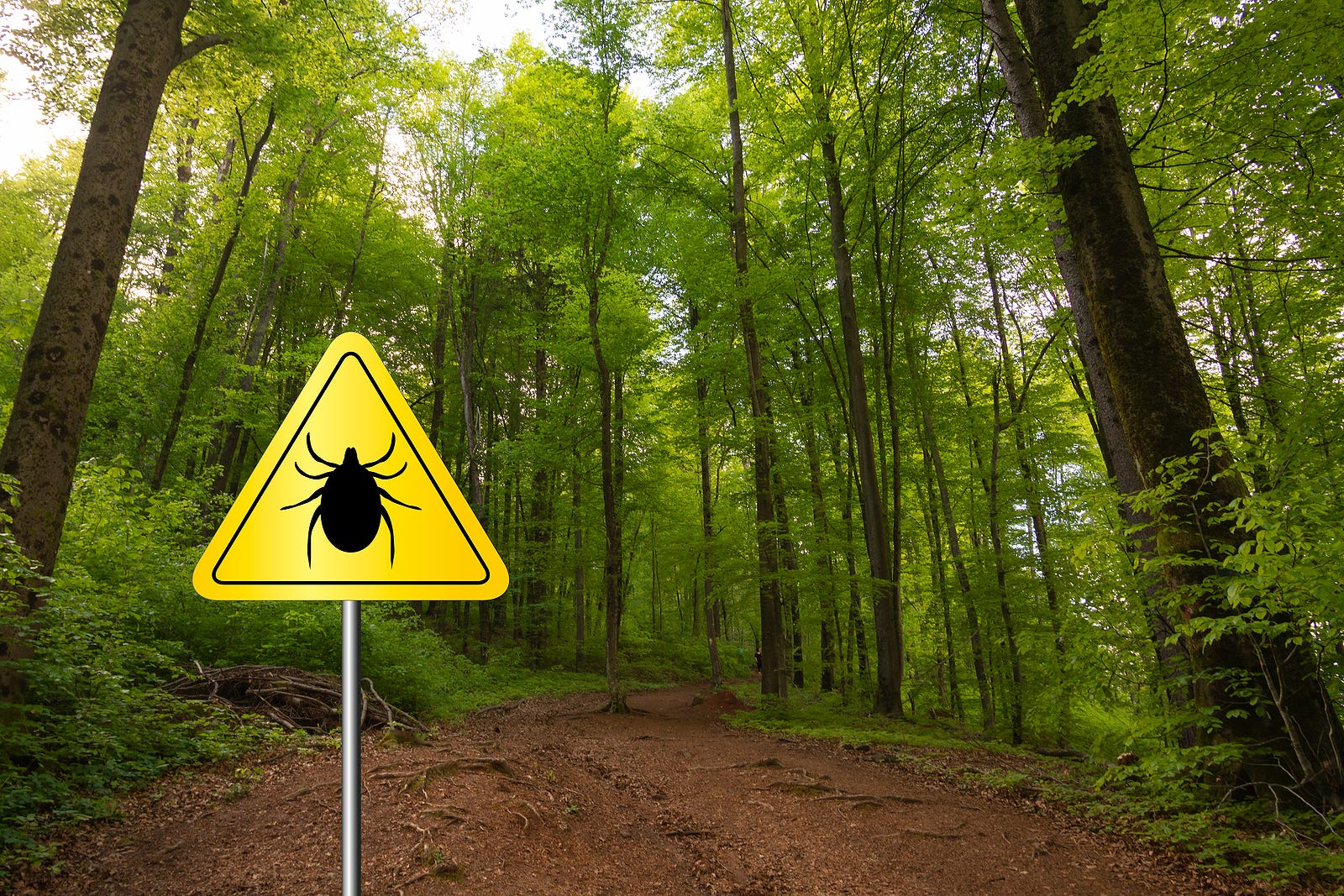- The prevalence of Lyme disease was reported to be 70% higher in 2022 than the annual U.S. average from 2017 to 2019, primarily due to changes in case reporting standards in high-incidence jurisdictions. High-incidence areas now report Lyme disease cases based on laboratory evidence alone, potentially inflating statistics due to eliminated requirements for clinical data
- Early symptoms of Lyme disease include a distinctive “bulls eye” rash, fatigue, and fever, progressing to more severe neurological and arthritic symptoms in later stages
- Diagnosing and treating Lyme disease is a complex affair, made even more complicated due to the frequent existence of co-infections
- Holistic specialists may integrate antibiotic therapy with dietary changes, lifestyle adjustments, and natural remedies to manage and treat Lyme disease
- Effective prevention includes avoiding tick habitats, using protective clothing, and using safe insect repellents like oil of lemon eucalyptus
According to research published in the February 15, 2024, issue of the U.S. Centers for Disease Control and Prevention’s Morbidity and Mortality Weekly Report (MMWR),1,2prevalence of Lyme Disease were 1.7 times (70%) higher in 2022 than the annual U.S. average reported from 2017 through 2019.
This dramatic increase is not thought to reflect an actual increase in prevalence but rather to changes in how cases are reported.
As of January 1, 2022, high-incidence jurisdictions — defined as having at least 10 cases per 100,000 population for three consecutive years — can report cases based on lab results alone, whereas low-incidence areas must include clinical data from patients with suspected infection. As reported by the CDC:3
“Lyme disease, a tickborne zoonosis caused by certain species of Borrelia spirochetes, is the most common vectorborne disease in the United States. Approximately 90% of all cases are reported from 15 high-incidence jurisdictions in the Northeast, mid-Atlantic, and upper-Midwest regions.
After the implementation of a revised surveillance case definition in 2022, high-incidence jurisdictions report cases based on laboratory evidence alone, without need for additional clinical information.
In 2022, 62,551 Lyme disease cases were reported to CDC, 1.7 times the annual average of 37,118 cases reported during 2017–2019. Annual incidence increased most in older age groups, with incidence among adults aged ≥65 years approximately double that during 2017–2019.
The sharp increase in reported Lyme disease cases in 2022 likely reflects changes in surveillance methods rather than change in disease risk. Although these changes improve standardization of surveillance across jurisdictions, they preclude detailed comparison with historical data.”
Revised Case Definitions in High-Incidence Areas May Muddle Statistics
The decision to allow high-incidence areas to forgo clinical confirmation data in their reporting was made to reduce the workload associated with reporting. According to the CDC, “As the number of Lyme disease infections has increased, the workload associated with collecting clinical information has proven prohibitive in several high-incidence jurisdictions.”
Unfortunately, these divergent reporting parameters also prevent accurate comparison of trends across jurisdictions. It could also result in falsely elevated prevalence rates over time.
That said, increases in Lyme disease cases has been documented through several lines of evidence, indicating that this tick-borne illness is becoming more prevalent, particularly in the northern hemisphere. For example, private insurance claims data show the prevalence of Lyme disease in rural areas increased by 357% between 2007 and 2021.4
The geographic distribution of Lyme disease has also expanded. Initially concentrated in the Northeastern U.S. and the upper Midwest, the range of black-legged ticks (Ixodes scapularis), which transmit Lyme disease, has been expanding gradually into the southern and western parts of the U.S. and into Canada.
How Lyme Disease Is Contracted
Lyme disease is contracted through the bite of an infected black-legged tick, commonly known as a deer tick. These ticks are primarily found in wooded and grassy areas. The tick becomes infected after feeding on infected deer, mice, or other small animals.
Transmission typically requires the tick to be attached for 36 to 48 hours or more, during which the bacteria in the tick’s gut moves to its salivary glands and into the host’s bloodstream.
Common Signs and Symptoms of Lyme Disease
The signs and symptoms of Lyme disease can vary and usually appear in stages:
1.Early localized stage — This occurs within days or weeks after the tick bite. The most recognizable feature is the appearance of erythema migrans, commonly known as a “bulls eye” rash, which occurs in approximately 70% to 80% of infected persons.
This rash expands gradually over several days and can reach up to 12 inches across. Other symptoms may include fatigue, chills, fever, headache, muscle and joint aches, and swollen lymph nodes.
2.Early disseminated stage — Weeks to months after the bite, the bacterium begins to spread throughout the body. This stage might include additional “bulls eye” rashes on other areas of the body, Bell’s palsy (loss of muscle tone on one or both sides of the face), severe headaches and neck stiffness due to meningitis, pain and swelling in the large joints (like knees), heart palpitations, and dizziness.
3.Late disseminated stage — This can occur months to years after the bite. Symptoms might include arthritis with severe joint pain and swelling, particularly in the knees and other large joints. Neurological complaints like shooting pains, numbness or tingling in the hands or feet, and problems with short-term memory can also occur.
Recommended Lab Testing
While diagnosis of Lyme disease is generally based on symptoms, physical findings (like the rash), and the possibility of exposure to infected ticks, laboratory testing can be helpful in the later stages of the disease when the possibility of false negatives is lessened. The two most used tests are:5
- Enzyme-Linked Immunosorbent Assay (ELISA) — This test detects antibodies to Borrelia burgdorferi. If ELISA is positive, it is usually followed by a Western blot test to confirm the diagnosis.
- Western blot — This test identifies antibodies to several proteins of Borrelia burgdorferi and is used to confirm ELISA results.
According to Dr. Dietrich Klinghardt, an expert on Lyme disease and its treatment, the IGeneX Lab in Palo Alto is the gold standard for Lyme testing, as they use two different antigens in their testing.
There’s also a useful indirect test called the CD57 test. “CD-57” is a specific group of natural killer cells that are particularly damaged by the Lyme spirochetes. Therefore, if your numbers drop to a certain level, it is an indirect indicator that you may have Lyme disease, because the only known infection to suppress CD57 is that of B. burgdorferi.
Co-Infections Are Common and Need To Be Considered
Lyme disease is primarily caused by the bacterium Borrelia burgdorferi, but co-infections by other pathogens carried by the same ticks is common. Testing has shown that nearly 1 in 4 black-legged ticks carry multiple infectious pathogens.6
These co-infections can significantly complicate the diagnosis and treatment of Lyme disease, as they cause overlapping and additional symptoms. Awareness of these co-infections is therefore critical for effective management and treatment of patients presenting with tick-borne disease symptoms. Some of the most common co-infections include:7
Babesiosis — Caused by Babesia microti and other Babesia species. This infection is similar to malaria and is caused by protozoans that infect your red blood cells. An estimated 40% of Lyme disease patients have concurrent Babesia infection.8
Anaplasmosis — Caused by Anaplasma phagocytophilum. Formerly known as human granulocytic ehrlichiosis (HGE), this bacterial infection affects white blood cells. An investigation by researchers from Columbia University, Tufts Medical Center and Yale School of Medicine, revealed that 2 in 3 patients with Babesiosis also have concurrent Lyme disease.9
Ehrlichiosis — Caused by Ehrlichia chaffensis and Ehrlichia ewingii. These bacteria also target white blood cells and are similar to the pathogens causing anaplasmosis but are generally associated with different species of ticks.
Bartonellosis — Caused by Bartonella henselae, Bartonella quintana and other Bartonella species. Known for causing cat scratch disease, these bacteria can cause a range of symptoms, from mild to severe.
Powassan virus disease — Caused by Powassan virus. This is a rare viral disease that can cause encephalitis (inflammation of the brain) and meningitis (inflammation of the membranes surrounding the brain and spinal cord).
Rocky Mountain spotted fever (RMSF) — Caused by Rickettsia rickettsii. Though less commonly transmitted by the same ticks that spread Lyme disease, RMSF can be transmitted by ticks and is a severe bacterial infection.
Tick-borne relapsing fever — Caused by Borrelia hermsii, Borrelia miyamotoi and other Borrelia species. These bacteria cause recurrent episodes of fever, headache, muscle and joint aches, and nausea.

Commonly Overlooked Factors in Diagnosis and Treatment
The complexity of co-infections and the difficulty that each infection poses when it comes to treatment makes Lyme disease a tough nut to crack. Patients are often misdiagnosed and/or mistreated.
For these reasons, if you suspect you have Lyme, it’s important to identify a Lyme specialist who has a holistic view of the problem and has more tools in his or her toolbox than never-ending rounds of antibiotics.
Factors that are commonly overlooked by conventional doctors include things like multi-drug resistant infections, the presence of biofilms, treatments that don’t cross the blood-brain-barrier, the necessity for detoxification, and the importance of general immune support.
Preventative Measures
Preventing tick bites is crucial in reducing the risk of Lyme disease. To reduce your risk of infection, be sure to:10
Avoid tick habitats — Ticks are commonly found in wooded, bushy, or grassy areas. When in these environments, stick to the center of trails to avoid brushing against vegetation where ticks may be waiting.
Wear protective clothing — Wear long sleeves, long pants, and long socks. Tuck your pants into your socks and your shirt into your pants to help keep ticks on the outside of your clothes. Wearing light-colored clothing can help you spot ticks more easily.
Check for ticks — After spending time in tick-infested areas, thoroughly check your body for ticks. Use a hand-held or full-length mirror to view all parts of your body and remove any tick you find. Also inspect your clothing, gear, and pets, as ticks can ride into the home on these and then attach to a person later.
Shower soon after being outdoors — Showering within two hours of coming indoors has been shown to reduce your risk of getting Lyme disease and may be effective in washing off unattached ticks.
Maintain your yard — Keep your yard neat by clearing tall grasses and brush around homes and at the edge of lawns, and by placing a 3-foot-wide barrier of wood chips or gravel between lawns and wooded areas to restrict tick migration into recreational areas. Mow your lawn frequently and keep leaves raked.
Protect your pets — Dogs are very susceptible to tick bites and can also bring ticks into your home. Talk to your holistic veterinarian about the best tick prevention products for your pet.
Use Safe Insect Repellents
While the CDC recommends using DEET on exposed skin, this strategy only replaces one potential health hazard with another. Remember, anything you put on your skin will enter your bloodstream, and while the CDC insists that DEET is safe when used as directed, there’s evidence to the contrary.
High concentrations of DEET or extensive application (especially in children) have been linked to neurological effects such as seizures, tremors, and in rare cases, encephalopathy. Allergic reactions are also common. DEET is also acutely toxic to dogs and cats, so never use this insect repellent on or around your pets.11 In my view, there are far safer options, including:
- Oil of lemon eucalyptus (OLE) — Derived from the leaves of the eucalyptus citriodora tree, OLE contains the active ingredient PMD (p-menthane-3,8-diol), which has been shown to offer protection against ticks. The CDC also recognizes OLE as an effective tick repellent.
- Cedar oil — Extracted from various types of conifers, cedar oil has a history of use as an insect repellent for landscapes and backyards. It acts as a natural pesticide and is effective against ticks, though its duration of effectiveness may be less than chemical alternatives.
- Nootkatone — This is a naturally occurring substance found in grapefruit12 and certain cedar trees. The Environmental Protection Agency (EPA) approved nootkatone for use in insect repellents and insecticides for human and animal use in August 2020.13 Nootkatone has shown efficacy in repelling and killing ticks and is a promising natural alternative.
- Neem oil — Derived from the seeds of the neem tree, neem oil has insecticidal properties and can repel a variety of pests, including ticks. It’s often used in natural pest control products and is safe for use around pets and wildlife. While considered safe to apply directly to bare skin, it’s very potent and can cause irritation if you’re sensitive.14 So, perform a small patch test before applying more liberally. If it’s too strong, you can mix it with another carrier oil of choice.
- Picaridin — While synthetic, picaridin is considered a safer alternative to DEET and is as effective. It’s derived from the compound found in the plants used to produce black pepper and does not carry the same neurotoxicity concerns as DEET.15
These alternatives offer varying degrees of protection and may need more frequent reapplication. The effectiveness of these products may also vary based on their concentration and the specific type of tick.
Treatment Recommendations by Holistic Specialists
Conventional Lyme treatment primarily depends on long-term use of antibiotics, but as detailed in a 2014 paper,16 B. burgdorferi has several defense mechanisms that make it hard to beat with antibiotics alone.
Holistic specialists therefore recommend a combination of antibiotic therapy, supportive holistic therapies, dietary and lifestyle adjustments, and detoxification to treat Lyme disease.
It’s crucial to work closely with a healthcare provider who understands Lyme disease thoroughly, as treatments need to be tailored to your specific symptoms and stage of disease. For reasons mentioned above, diagnosing Lyme is tricky business. Patience and persistence are required.
Negative test results are common when you have Lyme, as the spirochete has the ability to infect your white blood cells. Lab tests rely on the normal function of these cells, but when the white blood cells are infected with Lyme, they lose the ability to produce antibodies. Hence, nothing shows up on the test.
This is known as the “Lyme paradox,” and necessitates putting treatment before diagnosis. The idea is that by treating the infection, your white blood cells will regain their ability to mount a normal immune response, which can then be picked up by blood tests.
EMF Mitigation Is an Important Aspect of Treatment
In the video above, I interview Klinghardt about Lyme disease, testing, and treatment options. A list of his biological Lyme protocol can be found on KlinghardtInstitute.com.17 In 2017, he also published a paper18 in the American Journal of Immunology detailing his protocol for both the diagnosis and treatment of Lyme. It’s available as a free PDF download.
Klinghardt is adamant about patients addressing exposure to electromagnetic fields (EMFs) during treatment. In fact, he will not treat you unless you take steps to minimize your EMF exposure, as it can have a truly profound impact on the disease.
He’s convinced the increased virulence we’re now seeing is related to the dramatic increase in EMFs and microwave radiation from cellphones, cell towers, and all manner of wireless technologies.
According to Klinghardt, mitigating EMFs “has been a more successful strategy to treating Lyme disease and to get people neurologically well than any of the antibiotics or any of the antimicrobial compounds.” He also believes heavy metal toxicity exacerbates the problem.
Lumbrokinase Helps Break Down Biofilms
Another treatment component worth mentioning is lumbrokinase, a group of proteolytic (protein-digesting) enzymes that act as fibrinolytic agents. B. burgdorferi can live and thrive in biofilms inside your body, and lumbrokinase has been shown to help break down these infected biofilms.19
When pathogenic bacteria hide within biofilms, they can feed and replicate out of the reach of your immune system. As such, they remain strong and unaffected by any antimicrobial medications such as antibiotics and herbs that you may be taking.
The fact that lumbrokinase breaks down fibrinogen is an important aspect of Lyme treatment because the pathogenic bacteria use fibrinogen, which they convert to fibrin, to strengthen their network.
Lyme expert Dr. Marty Ross, an integrative medicine specialist and founder of The Healing Arts Partnership in Seattle, uses lumbrokinase, both alongside antibiotics, and for patients in whom antibiotics fail.20
If you and your doctor determine lumbrokinase is right for you, be sure to buy a high-quality, reputable brand. Certain brands are available in capsule form at a dose of 600,000 IU (international unit), or 40 mg, which are recommended for Lyme sufferers in the form of a daily dose of 1 to 2 capsules taken in the morning, afternoon and at bedtime.
Generally, lumbrokinase should be taken only under the advisement of your doctor and can be dangerous if taken with blood-thinning medication. In addition, it’s contraindicated in all medical conditions associated with an increased risk of bleeding.
ORIGINALLY PUBLISHED BY: DR. JOSEPH MERCOLA.
Sources and References
1, 3 MMWR February 15, 2024; 73(6): 118-123
7, 8, 9 Daniel Cameron MD What Are Lyme Disease Co-infections?
11 Covetrus DEET Dangerous to Pets
12 Mini Rev Med Chem 2022;22(17):2244-2259
14 Medical News Today December 3, 2019
15 EWG’s guide to bug repellents
17 Klinghardt Institute Lyme Protocol
18 American Journal of Immunology 2017; 13(2): 114-126
19 Evidence-Based Complementary and Alternative Medicine December 12, 2013; 2013: 783971












